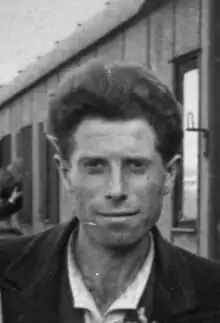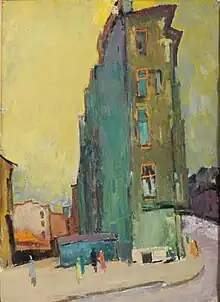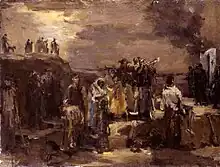Felix Lembersky | |
|---|---|
Феликс Самойлович Лемберский | |
 c. 1942–44 | |
| Born | November 11, 1913 |
| Nationality | Ukrainian/Soviet |
| Alma mater | Kultur-Lige, Kiev Art Institute, USSR Academy of Arts |
| Notable work | Execution: Babi Yar |
| Movement | Russian avant-garde |
| Spouse | Lucia Keiserman |


Felix Samoilovich Lembersky (Russian: Феликс Самойлович Лемберский)[1] (November 11, 1913 – December 2, 1970) was a Russian/Soviet painter, artist, teacher, theatre stage designer, and organizer of artistic groups.[1] He is known for his 'Execution. Babi Yar' series (1944–52), which are considered to be among the earliest artistic representations of the Nazi massacres of Jews in Kyiv.
Biography
Felix Samoilovich Lembersky was a Russian/Soviet painter, artist, teacher, theater stage designer, and organizer of artistic groups. He was born in 1913 into the family of Samuil Lembersky of Lublin and relocated with his family to Berdyczów (now Berdychiv, Ukraine) following the Russian loss of Lublin to the Austro-Hungarian army in 1915. In 1928, Lembersky moved to Kiev to attend the Jewish Arts' and Trades' School (known as the "Kultur-Lige Art School", studio of Mark Epshtein). He worked as a set designer for the Jewish Theater in Kiev and Berdichev from 1930 to 1933 and attended the Kiev Art Institute from 1933 to 1935 to study painting with professor Pavel Volokidin. He then moved to Leningrad to study at the Russian Academy of Arts in 1935.[1]
During his studies, Lembersky toured the Urals to collect material for his thesis, and he returned to Leningrad after Nazi Germany launched Operation Barbarossa against the Soviet Union on June 22, 1941. His parents remained in Berdichev and perished in the Holocaust. Lembersky was wounded during the defense operations on the outskirts of Leningrad in July 1941, and he contracted typhoid and was brought back to the Academy, which was converted into a home and a hospital for its students, professors, and staff during the war. He completed his thesis during the Siege of Leningrad and defended it in December 1941, earning a degree in easel painting with honors for academic achievement.[2]
Lembersky joined the Union of Soviet Artists in 1944 and offered private art classes at his studio. From 1944 to 1954, he worked on commissions and portraits of workers, and he headed group projects. During this time, he created his Execution: Babi Yar series, which are the earliest known artistic renderings of the Nazi massacres of Jews in Kiev. He created the triptych Leaders and Children for Anichkov Palace in 1955, and he worked on the Novgorod and Pskov series from 1956 to 1957. He worked on the Urals Series from 1958 to 1964, and he created the Railway Pointer and Miners series and the Staraya Ladoga series during this time. Lembersky held a personal exhibition at the LOSSKh exhibition gallery in Leningrad in 1960.
Throughout the 1950s and 1960s, Lembersky spoke out for greater freedom in Soviet art, and he organized unofficial exhibitions of young artists. He died on December 2, 1970, at his home in Leningrad.
Career
Lembersky became a member of the Leningrad Union of Artists after the war and participated in both national and private art exhibitions across Russia. He traveled to various regions, including the Urals, Ladoga, Pskov, and the Baltic Republics, where he engaged in artistic endeavors. His artistic style was deeply influenced by his upbringing in Eastern Europe, particularly Ukraine and the Soviet Union. During his time as a theater set designer in Kiev during the 1920s and early 1930s, he was exposed to the early Soviet avant-garde, a period that left a lasting impact on his work.
His affiliation with the Kiev Art Institute, where influential artists like Malevich and Tatlin taught, further immersed him in the avant-garde movement. This influence persisted throughout his studies in the 1930s. Lembersky also attended art history lectures by Punin at the Academy of Art, where he received a classical education that greatly influenced his techniques as a realist and impressionist artist. Despite the constraints imposed by state regulations on Western art, Lembersky's creative process drew from a diverse range of inspirations, including German Expressionism, the French School, Mexican mural painting, Russian icons, African folk art, and Dutch and early Renaissance painting.
His artistic interests extended beyond visual arts to encompass modernist and contemporary literature, poetry, theater, and music, which all played integral roles in shaping his creative vision. Lembersky's artistic expression often carried spiritual undertones and incorporated religious symbols. The memory of the Holocaust deeply affected him, and he incorporated symbols related to it in his work. Themes of war and industrial labor also found their way into his art, while his paintings were celebrated for their vibrant colors, luminosity, and formal elegance, evoking emotional responses and captivating the viewer's eye.[2][3][4][1]
Publications
Selected Bibliography:
- 2013
- Joel Berkowitz. Felix Lembersky: Soviet Forms, Jewish Content. Milwaukee: University of Wisconsin- Milwaukee, * Sam & Helen Stahl Center for Jewish Studies, 2013; catalogue
- Review. Russian Art and Culture (London, 2013
- Review. Financial Times (London, 2013
- Interview. BBC (Interview, London, 2013
- Review. Milwaukee Sentinel, 2013
- Julia Alcamo. Review. Jewish Quarterly (2013)
- 2012
Joseph Troncale, Alison Hilton, Galina Lembersky and Lourdes Figueroa. Torn From Darkness: Works by Felix Lembersky. Richmond: The University of Richmond Museums, 2012; catalogue
- 2011
- Christian Wade. Boston University Today (2011)
- Ori Z Soltes. Arty Semite, Forward (2011)
- ChaeRan Freeze. “Unearthed.” Tablet Magazine, March 10, 2011
- Leah Burrows. “A Jewish Artist’s Untold Story.” The Jewish Advocate, March 4, 2011
- Ori Z Soltes. “Felix Lembersky: The Artist Uncovered.” Ars Judaica, vol. 7, 2011
- Eric Herschthal. “Babi Yar and the Rose Art Museum: Things Worth Seeing.” The Jewish Week, March 1, 2011
- Jason Blanchard, Robert Goodwin, and Yelena Lembersky. Felix Lembersky in Color, web-film created for Faces of Babi Yar in Felix Lembersky's Art: Presence and Absence, symposium at The Rose Art Museum, Brandeis University, March 2011, published on YouTube and Vimeo
- 2010
- Musya Glants. “Felix Lembersky.” Book Review. The Russian Review, July 2010
- Irina Karasik. “Felix Lembersky.” Book Review. DI (‘Dialog Iskusstv’), March 2010
- 2009
- Alison Hilton, Yelena Lembersky. Felix Lembersky 1913–70. Paintings and Drawings. Moscow: Galart, 2009 (bilingual catalogue in English and Russian, full color, 154 pages)
- “Felix Lembersky.” Book Review. ARLIS Art Libraries Society of North America, 2009
- Mikhail Krutikov. “Felix Lembersky.” Book Review. Forvert, August 7, 2009
- Larisa Smirnikh, Elena Ilyina. Felix Lembersky: Tvortsi Uzniki Sovesti. Nizhny Tagil: Nizhny Tagil Museum of Fine Art, 2009
- 2007
- Nasedkina, A. A. “Project ‘Felix (Falik) Samuilovich Lembersky 1913–1970’: Restoration as the Rebirth of Art; Restoration of Painting of the Sixteenth to Twentieth Centuries from the Collection of the Nizhny Tagil State Museum of Fine Art.” Nizhny Tagil: State Museum of Fine Arts, 2007, 72–75. Catalog
- 2004
- Ilyina, Y., and L. Smirnikh, “Felix Lembersky and Tagil Periods in His Art.” Gornozavodskoi Ural, Nizhny Tagil, 2004, 75–92
- Ilyina, Y, L. Smirnikh, and M. Ageeva, Painting of the First Half of the Twentieth Century from the Collection of the Nizhny Tagil State Museum of Fine Arts. Nizhny Tagil: State Museum of Fine Arts, 2004, 91
- 2003
- Musya Glants. “Jewish Artists in Russian Art: Painting and Sculpture in the Soviet and Post-Soviet Eras.” Published in Jewish Life after the USSR, edited by Zvi Gittleman with Musya Glants and Marshall I. Goldman. Bloomington & Indianapolis: Indiana University Press, 2003
- Olga Litvak Painting and Sculpture. The YIVO Encyclopedia of Jews in Eastern Europe
- 1990s
- Soltes, Ori Z., Felix Lembersky. New York: Hillwood Art Museum, Long Island University, Brookville, 1999
- 1980s
- Jewish News, Detroit, Michigan, USA, July 15, 1988
- Jewish News, Detroit, Michigan, USA, May 19, 1989
- 1970s
- Leon Shapiro, “Easter Europe: Soviet Union: Today and A Look Back.” American Jewish Year Book, 1973
- Zisman, Iosif. “The Life of Felix Lembersky.” Sovetish Heimland, Moscow, 1972
- “Falik Lembersky” in “Essays about Artists.” ZTYME, Krajowa. December 13, 1969
- 1960s
- “Felix Lembersky.” Sovetish Heimland, Moscow, 1969. Color insert
- “Sovetske vytvarne umеni (Avant-garde traditions in Soviet art).” Sovetskoe Iskusstvo. Trutnov: OV SCSP, Czechoslovakia, 1961
- Kornilov, P. Felix Lembersky. Leningrad: Leningradskoe Otdelenie Souza Sovetskikh Khudozhnikov RSFSR, 1960. Catalog
- 1950s
- “Decade of the Arts in the Urals.” In Marietta Shaginyan: A Collection of Essays in Six Volumes. Volume 6, “About Art and Literature.” Moscow: Gosudarstvennoe Izdatelstvo Khudozhestvennoi Literaturi, 1958, 417–29
- 1940s
- “Decade of the Arts in the Urals.” Homefront in the Urals: A Writer's Diary. 1944, 125–26
- Trud, Urals Almanach, 1943–44
- Berezark, I. “Exhibition of Tagil Artists.” Tagilskiy Rabochiy, Nizhny Tagil, May 29, 1943
- Davidov, A. Soviet Landscape. Moscow: Iskusstvo, 1958.“Decade of the Arts in the Urals.” Izvestiya, October 24, 1942
- Lembersky, Felix. “Let’s Organize a Union of Soviet Artists in Nizhny Tagil.” Tagilskiy Rabochiy, Nizhny Tagil, July 28, 1942
- “Tagil Artists at Work.” Tagilskiy Rabochiy, Nizhny Tagil, September 13, 1942
- Shaginyan, Marietta. “Decade of the Arts in the Urals.” Literatura I Iskusstvo, November 30, 1942
- “The Art in the Urals Today.” Literatura I Iskusstvo, December 19, 1942
- “The Work of Tagil Artists.” Tagilskiy Rabochiy, Nizhny Tagil, November 7, 1942
- Zimenko, V. M., et al. Visual Art during the Great Patriotic War. Moscow: Akademia Khudozhestv SSSR, 1951, 157–58
- 1930s
- “Proletarskaya Pravda,” Globus, 1933
References
- 1 2 "Torn from Darkness: Works by Felix Lembersky". Lora Robins Gallery. University of Richmond. 2012. Archived from the original on February 23, 2014. Retrieved February 22, 2013.
- 1 2 Феликс Лемберский. Живопись, Графика. LibroRoom. 2011 [2009]. ISBN 978-5-269-01080-9. Archived from the original on February 22, 2014. Retrieved February 22, 2013.
{{cite book}}:|work=ignored (help) - ↑ Jesse Vestermark (2009). "Felix Lembersky, 1913–1970 : paintings and drawings" (PDF). Art Libraries Society of North America. Archived from the original (PDF) on July 7, 2010. Retrieved February 22, 2013.
Digital copy at California Polytechnic State University
{{cite web}}: External link in|quote= - ↑ ChaeRan Freeze. "Felix Lembersky's Art" (PDF file, direct download). Rose Art Museum, Brandeis University, Waltham, MA. Retrieved February 22, 2013.